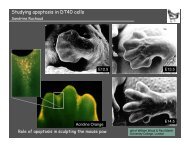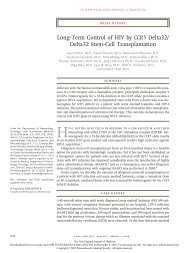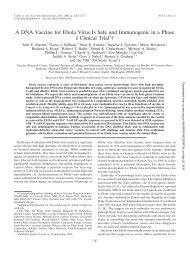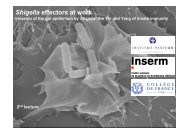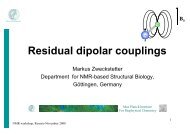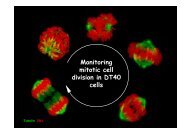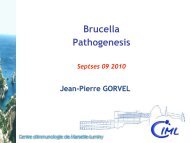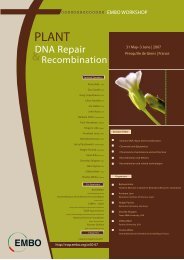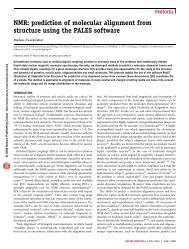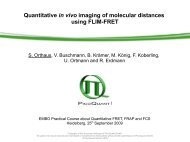DT40: Basic culture and common problems
DT40: Basic culture and common problems
DT40: Basic culture and common problems
You also want an ePaper? Increase the reach of your titles
YUMPU automatically turns print PDFs into web optimized ePapers that Google loves.
<strong>DT40</strong><br />
<strong>Basic</strong> <strong>culture</strong> <strong>and</strong> <strong>common</strong> <strong>problems</strong>
<strong>DT40</strong><br />
• ALV-induced bursal lymphoma from female (ZW) F1<br />
White Leghorn chicken 1<br />
• similar phenotype to human Burkitt’s lymphomas:<br />
p53 null <strong>and</strong> degregulated MYC expression<br />
• triplication of chromosome 2<br />
taken from Winding & Berchtold (2001)<br />
J. Immunol. Meth. 249, 1-16<br />
ER, endoplasmatic reticulum;<br />
M, mitochondria;<br />
N, nucleus;<br />
V, viral particles.<br />
• c. 10µm in diameter in G1, 12µm in G2<br />
• famously high frequency of targeted to<br />
r<strong>and</strong>om integration 2<br />
1. Baba T.W. et al. (1985) Cell lines derived from avian lymphocytes exhibit two distinct phenotypes Virology 144, 139-151.<br />
2. Buerstedde J.-M. <strong>and</strong> Takeda, S. (1991) Increased ratio of targeted to r<strong>and</strong>om integration after transfection of chicken B cell lines Cell<br />
67, 179-188.
<strong>DT40</strong> <strong>culture</strong> conditions<br />
• base medium<br />
• serum<br />
• antibiotics<br />
• 2-mercaptoethanol?<br />
• CO2<br />
• temperature
<strong>DT40</strong> growth characteristics<br />
doubling time 11 hours at 37˚C
<strong>DT40</strong> growth characteristics<br />
doubling time 11 hours at 37˚C
<strong>DT40</strong> growth characteristics<br />
doubling time 11 hours at 37˚C<br />
Edmunds et al. Molecular Cell, 2008, 30, 519-29
<strong>DT40</strong> growth characteristics<br />
• ideally aim for density between 2 x 10 5<br />
<strong>and</strong> 1x10 6 /ml...this really means splitting<br />
every day but with care you can reduce<br />
this to every 48 hours<br />
97% viable<br />
17% viable
• infection<br />
<strong>DT40</strong> <strong>common</strong> <strong>culture</strong><br />
<strong>problems</strong><br />
• <strong>DT40</strong> is happy with most <strong>common</strong> antibiotics e.g. penicillin, streptomycin.<br />
• Gentamicin <strong>and</strong> ciprofloxacin can be useful in extremis.<br />
• Fluconazole for fungal infection<br />
• For us, mycoplasma infection is very un<strong>common</strong>; can be treated with<br />
ciprofloxacin or BM-cyclin (Roche) although latter is quite toxic
• clumping<br />
<strong>DT40</strong> <strong>common</strong> <strong>culture</strong><br />
<strong>problems</strong><br />
• exclude low-grade infection, especially with fungi<br />
• sometimes happens in conditions of low or poor serum<br />
• ?sometimes antibody mediated<br />
• sticking to plastic<br />
• can certainly be antigen-receptor mediated<br />
(Cumbers et al. Nat. Biotechnol 2002, 20, 1129-34.)<br />
• usually pretty low affinity - can be largely knocked off<br />
• however, difficult to ‘cure’ - if a problem, probably have to find another clone
Culture of <strong>DT40</strong> on<br />
methylcellulose<br />
• useful for immobilising <strong>DT40</strong> for e.g. colony<br />
survival assays<br />
• autoclave 10g of methylcellulose in<br />
a 1L bottle with stir bar<br />
• fully disperse methylcellulose in<br />
warm water<br />
• add 2x medium bit-by-bit with<br />
energetic shaking<br />
• top up to IL <strong>and</strong> stir in cold room<br />
overnight<br />
• the medium should be crystal clear<br />
- precipitates of methylcellulose are<br />
bad news...
Cloning <strong>DT40</strong><br />
• cloning by limiting dilution<br />
• cloning by cell sorter<br />
• ensure cells are in tip-top<br />
condition; generally no need for<br />
conditioned medium<br />
• in both cases this is very<br />
straightforward but is improved by<br />
using round-bottomed 96-well<br />
plates<br />
• consider increasing serum to 15%<br />
total if cloning efficiency is low
• Electroporation<br />
Getting DNA into <strong>DT40</strong><br />
• High energies (e.g. 250V, 950µF in a 4mm cuvette) favour r<strong>and</strong>om integration<br />
through formation of DNA breaks<br />
• For gene targeting a lower energy, higher voltage approach is better (e.g.<br />
550V, 25µF in a 4mm cuvette)<br />
• generally 20 million cells per transfection works well<br />
• 10 - 30µg DNA in water (volume
Getting DNA into <strong>DT40</strong><br />
• Amaxa nucleofection<br />
• works very well for transient transfection - st<strong>and</strong>ard lipid-based transfection<br />
(e.g. Lipofectamine <strong>and</strong> FuGene) have been hopeless in our h<strong>and</strong>s;<br />
electroporation is inefficient<br />
• needs special electroporator, solutions <strong>and</strong> cuvettes - expensive<br />
• somewhat limited in number of cells that can be transfected<br />
• Solution T <strong>and</strong> program B23 work well<br />
• cells hate being in nucleofector solution, so fiddly to do large numbers if you<br />
want it to work (although there are plate-based options around)
• Transduction<br />
Getting DNA into <strong>DT40</strong><br />
• allows introduction of transgene without the<br />
cellular stress associated with electroporation<br />
• highly efficient using VSV-G pseudotyped MMTVbased<br />
amphotropic virus<br />
• requires Class II containment facilities (normally<br />
<strong>DT40</strong> is Class I)<br />
• first step is virus production in 293 cells. The virus is<br />
produced by co-transfection of three plasmids: one<br />
encodes gag & pol, one the VSV-G pseudotyped env <strong>and</strong><br />
the third your gene of interest linked to a viral<br />
packaging signal.<br />
• virus is harvested in supernatant <strong>and</strong> can be frozen<br />
• the viral supernatant can then be used to infect <strong>DT40</strong><br />
cells<br />
R<strong>and</strong>ow & Sale, <strong>DT40</strong> h<strong>and</strong>book
Stable selection<br />
• Commonly used selection markers<br />
Drug<br />
G418<br />
Puromycin<br />
Resistance<br />
gene<br />
Final<br />
concentration<br />
Notes<br />
neomycin<br />
phosphotransferase 2 mg/ml slow; cells may need feeding<br />
puromycin<br />
acetyltransferase<br />
0.5 µg/ml<br />
generally clean; cells can take<br />
several days to die<br />
Blasticidin S blasticidin S deaminase 20 µg/ml rapid with clean selection<br />
Histidinol histidinol dehydrogenase 20 µg/ml<br />
Hygromycin B<br />
hygromycin<br />
phosphotransferase<br />
1.4 mg/ml<br />
Mycophenolic acid E. coli XGPRT 15 µg/ml<br />
Zeocin<br />
extremely rapid with clean<br />
selection<br />
batch to batch variation in amount<br />
of active compound<br />
need to add xanthine <strong>and</strong><br />
hypoxanthine; quick <strong>and</strong> clean<br />
Streptoalloteichus.<br />
hindustanus Ble 300 µg/ml works by causing DNA breaks
•<br />
•<br />
•<br />
•<br />
•<br />
Marker recycling with Cre<br />
recombinase<br />
Amaxa transfection of Cre recombinase expression<br />
plasmid<br />
next day, plate out at 1, 3, 5 viable cells per well<br />
grow up <strong>and</strong> select clones from plates with fewest<br />
positive wells i.e. from 1c.p.w. if it has worked<br />
pick clones to 24-well plate containing normal medium<br />
once established in 24-well plate, replica plate to selective<br />
media, keeping cells thin to ensure clear selection...<strong>and</strong><br />
remember to keep the plate with no antibiotic!
• Freezing mix<br />
• Freezing tubes<br />
Cryopreservation<br />
• 90% serum / 10% DMSO<br />
• slow down, quick up<br />
• Freezing plates<br />
• Storage<br />
• Recovery after freezing
Questions?



